The next morning, back in 2001, the whole group I travelled with got up at down, since right after the early breakfast we had to leave the cruise ship. Namely, during the night we reached Luxor and docked there. When we disembarked we were met by a tourist bus to which we transferred our luggage and when we went for the sightseeing of Luxor and its surroundings by that same bus.
Luxor is the name of a contemporary city that is located in the place where there used to be the Ancient Egyptian town called Thebes. This Thebes should not be mixed up with the Ancient Greek Thebes, the archaeological remains of which may be found some 60 km northwest of Athens.
So, the Ancient Egyptian Thebes was populated already from 3200 BCE. During the Old Kingdom (2686-2181 BCE), when Memphis was the capital of Ancient Egypt, Thebes was just a smallish place in Upper Egypt. Then came some kind of a dilution of the authority and the state was divided, while that time is called the 1st Intermediate Period (2181-2055 BCE). At the end of that period, members of the 11th dynasty ruled in Thebes and they in fact reunited Egypt (i.e., brought the whole territory under the rule of one pharaoh), thus starting the Middle Kingdom (2055-1650 BCE) and at that time Thebes became the capital that was also the most important religious centre of the country.
Over time, the state disintegrated again and so we come to the Second Intermediate Period (1650-1550 BCE) and during that time Thebes played the function of the capital of one part of the country only for a while.
Then the country reunited again under the reign of the founder of the 18th dynasty, Amhose I, and became what the 19th century (CE) Egyptologists called the New Kingdom (1550-1069 BCE). This kingdom lasted throughout the reigns of the members of the 18th, 19th and 20th dynasties.
During the period of the New Kingdom, Thebes was the capital a couple of times (1550-c. 1352 BCE and from c. 1336-1279 BCE). I have already mentioned this period when I wrote about Tutankhamun and his father, Pharaoh Akhenaten, (1352-1336 BCE). It was precisely the latter who decided to get out of the claws of the extremely influential high priests and so he changed the religion into a monotheistic one and moved the capital to Akhetaten. All of this was short lived and after his death the capital went back to Thebes again.
It remained there until great Ramesses II came to the scene who kept building all over the place (his is Abu Simbel that I have already written about) and so he also developed his new capital Pi-Ramesses in the Nile delta. Although the capital of Ancient Egypt continued to be moved throughout the history, Thebes never regained this status again, but it remained an important religious and spiritual centre.
The name Thebes is usually used in order to designate the capital of Ancient Egypt from the distant past, but this name was actually given to the city by Ancient Greeks. As the time went by, the city kept changing its name and so we come to the present-day Luxor.
Luxor is a contemporary city that is located around 700 km south of Cairo on the riverbank of the Nile. Although a lot of its residents deal with agriculture (especially the growing of sugarcane) and other industrial activities, the backbone is tourism and everything around it. It is often said that Luxor is the biggest open-air museum in the world. And indeed – a half-day or a full-day visit is simply not enough to see everything nicely, although this does provide a very good idea of the importance of this city in the past.
I visited the city with a tourist group in 2001, as well as in 2021, but this second time I did not visit all the places like the first time and so I will start from the Luxor Temple which I visited only in 2001.
The Luxor Temple is in fact a large temple complex on the east bank of the Nile originally built around 1400 BCE, i.e., in the period of the 18th dynasty (primarily Pharaoh Amenhotep III (or Amenophis III)), but it was significantly expanded also during the 19th dynasty (specifically during the reign of Pharaoh Ramesses II).
The Ancient Egyptians used to call it, more or less, “the south temple” since in the Ancient Egyptian Thebes there was another, more important and larger one situated in the north of the city, around 2.5 km farther – the Karnak temple complex.
The Luxor Temple was dedicated to the Theban Triad, i.e., god Amun, his wife Mut and their son Khonsu. Amun was one of the most important gods in Ancient Egypt ever since the very beginning of this civilisation. From the 11th dynasty (c. 2100 BCE) he was declared the patron god of Thebes and with the establishment of the new Kingdom he was conjoined with the Sun god Ra, from then on appearing as Amun-Ra. This was the supreme god (the Ancient Greek equivalent was Zeus) and the creator of the soul.
His wife in this case (since there were a few more in the early phases of the Egyptian history) was Mut – the goddess of motherhood who was considered the mother of everything in the world (her name, Mut, in the ancient Egyptian means “mother”). She was also the mother of a son with Amun and that was the god of the Moon or the lunar god – Khonsu. Just like his father travelled the sky during the day (as the Sun), Khonsu travelled the sky at night.
But, although I have explained all of this quite nicely here, there is also data that says that the Luxor Temple was not dedicated to any deity in particular or that it was dedicated only to god Amun in his specific form, Amun-Min, in which he is conjoined with the god of fertility Min. Still, after all, this was probably important only to the Ancient Egyptians. What matters for contemporary visitors is that this is a truly impressive place.
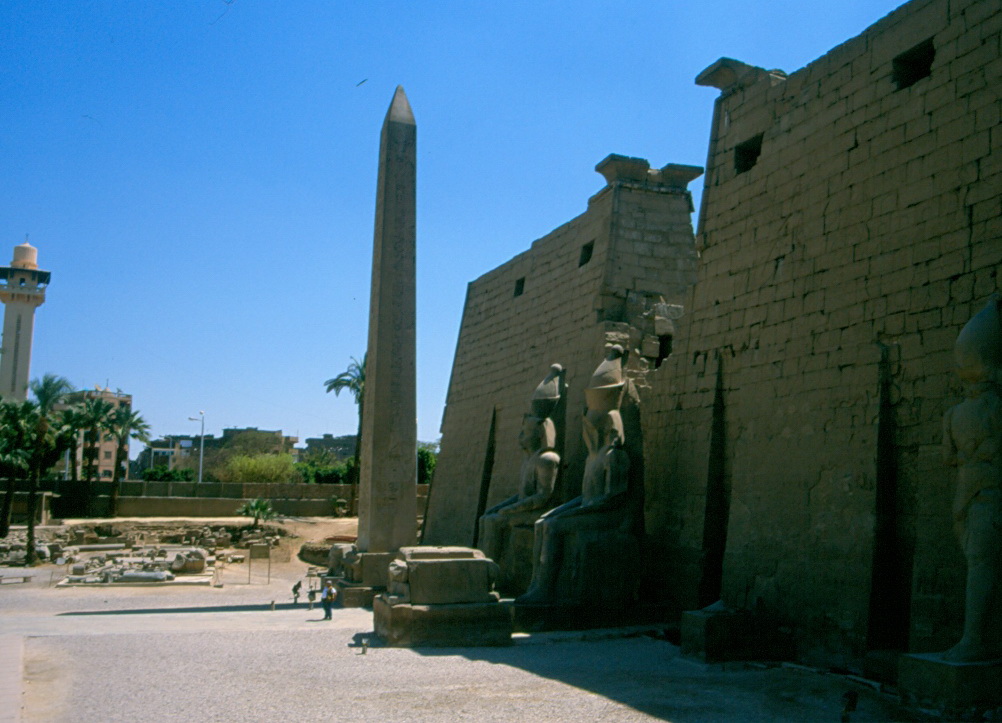 Entrance into the Luxor Temple
Entrance into the Luxor Temple
To start with, the visitor comes to the very entrance into the temple which faces north where, as I’ve said, 2.5 km farther there is the main temple complex of Ancient Thebes – Karnak.
Today, near the entrance, one can see a 25 m high obelisk. There used to be two of them, but that other one was taken by the French and placed in Paris at the Place de la Concorde (you can see it in my travelogue about Paris on https://www.svudapodji.com/en/paris-4/).
In addition, there are also colossal sitting figures of deified Pharaoh Ramesses II places in front of the pylon.
When you go through the pylon, you enter a courtyard built by Ramesses II. However, one should bear in mind that, with time, the Luxor Temple was buried under sand up to the half the height of the pylon and so the ground zero changed throughout the history. And so did the religions. That means that, after the Ancient Egyptians, there came the Ancient Romans who more or less locally accepted the Ancient Egyptians gods, but still, in 395 CE, they turned a part of the temple into a church. That church kept functioning here until 640 CE, when a part of the temple was turned into a mosque. And that mosque, Abu Haggag, has been active ever since. That means that the Luxor Temple is the oldest building in the world that is active at least by one part of it, rather than being a mere archaeological ruin. Also, you can practically see elements of three religions in the same place (we saw parts of the church, including the already paled wall paintings, a little later, after the Hypostyle Hall).
In the photo below you can see where the mosque was created and up to which level there used to be sand in the past. The mosque wall is painted and it can be discerned in the middle on the right-hand side of the photo. During the excavations of the Luxor Temple, great care was put into not damaging the mosque.
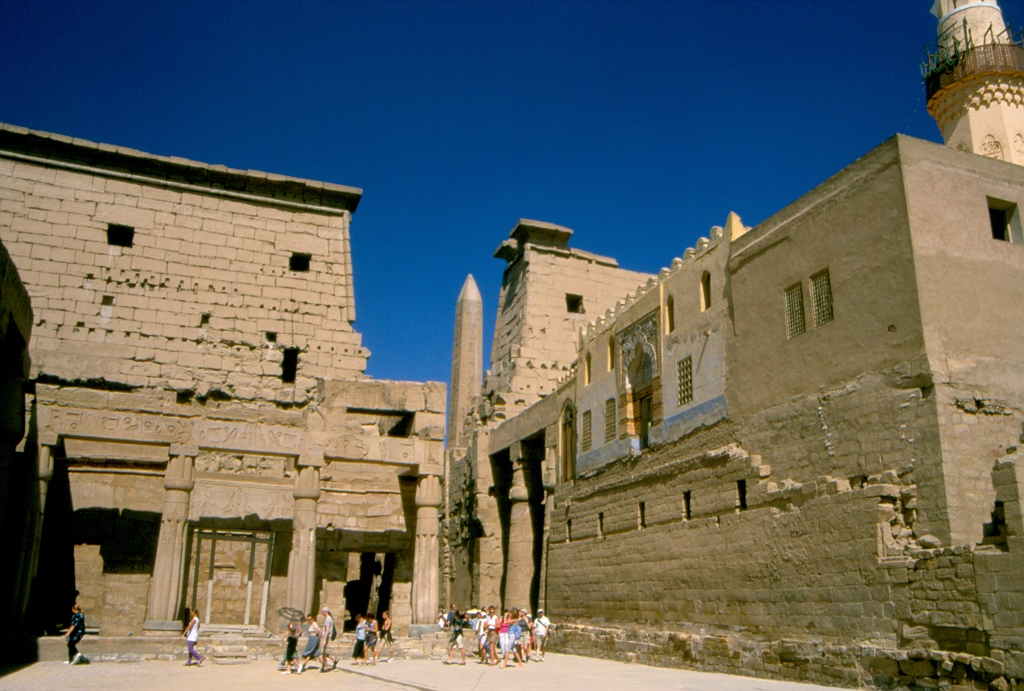 Court of Ramesses II
Court of Ramesses II
The photo also shows the Court of Ramesses II with the dimensions of 57 x 51 m, as well as the back side of the pylons and the obelisk that stands at the very entrance into the temple.
On the opposite, south side of the courtyard, between the pillars, there are numerous standing sculptures of Ramesses II.
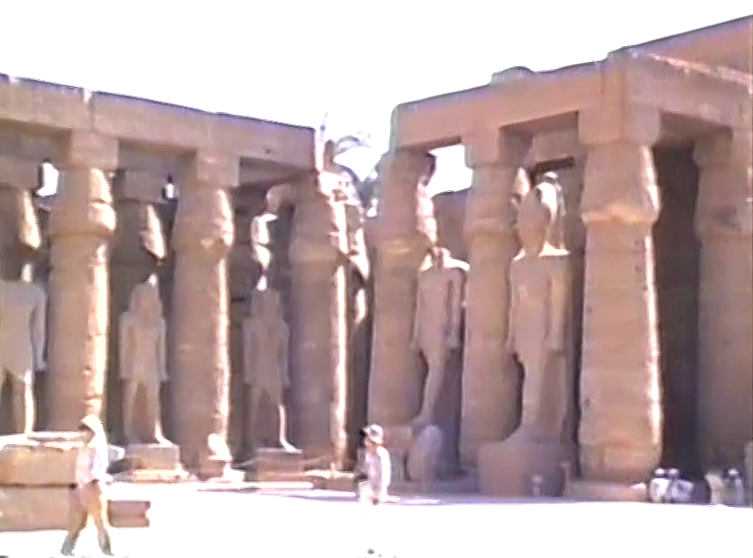 Court of Ramesses II
Court of Ramesses II
When I continued further with the visit moving on from the courtyard, I also saw a nice relief of the Ancient Egyptians’ god Hapi on a wall.
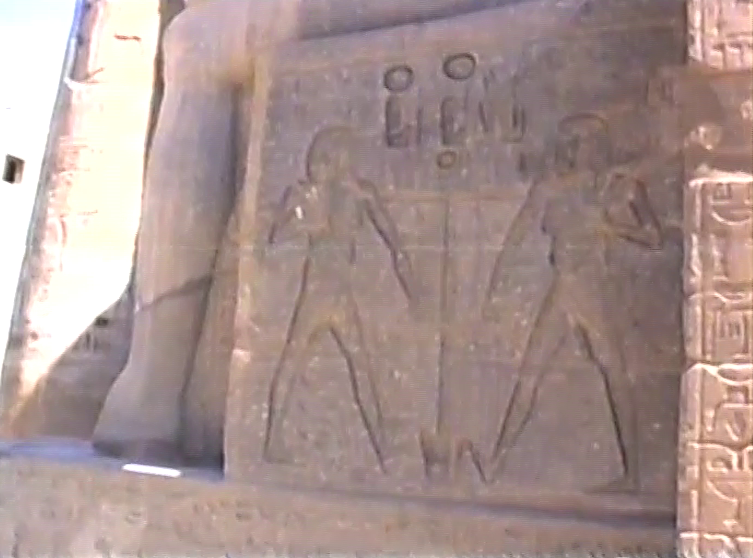 God Hapi
God Hapi
God Hapi was very important for the Ancient Egyptians, since he was the god of the Nile and the floods. Some people considered him to be more important even from Ra, the god of Sun, himself, for they believed they could live without the Sun, but not without the Nile. God Hapi was often depicted as a pair of figures, as a symbol of the link between the Upper and the Lower Egypt. You cannot see clearly in the photo above, since it is blurry, but beside the two representations of the god there are chiselled lotus and papyrus flowers symbolising the two parts of the kingdom.
The next segment of the temple is the Colonnade of Amenhotep III. The colonnade consists of seven pairs of columns that are 16 m high and that have capitals made in the shape of an open papyrus flower. It needs to be borne in mind that before the interventions of Ramesses II the entrance into the temple used to be here.
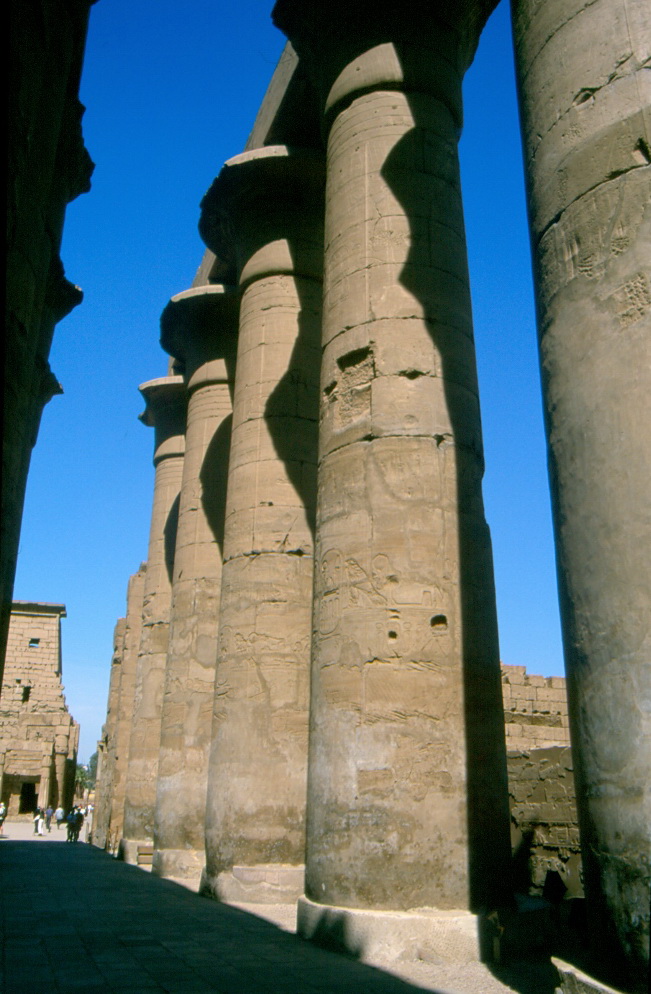 Colonnade of Amenhotep III (further down there is the Court of Ramesses II)
Colonnade of Amenhotep III (further down there is the Court of Ramesses II)
Then we moved to the Court of Amenhotep III in which on the left and right sides as we proceeded (the east and the west sides of the temple) there were double rows of columns. The columns on the south side turn into the Hypostyle Hall.
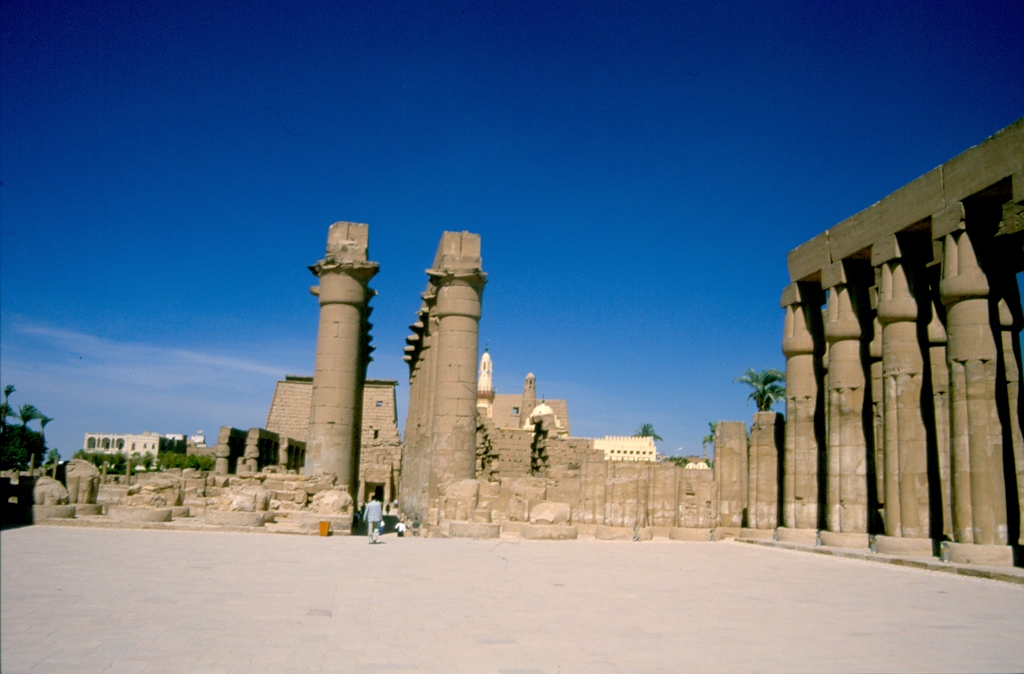 Court of Amenhotep III: the Colonnade of Amenhotep III is straight, while a part of the flanking columns is to the right
Court of Amenhotep III: the Colonnade of Amenhotep III is straight, while a part of the flanking columns is to the right
The Hypostyle Hall consists of 32 columns and behind it one continues further towards the inner sanctum. The elements of the Christian church may be seen precisely here.
In this part of the temple there are also several smaller rooms, the Chapel of Alexander the Great, as well as the inner sanctum. As for the inner sanctum, this was the holiest part of the temple which nobody but the pharaoh and the high priest was allowed to enter. As for Alexander the Great, he had this chapel built and he used to claim that he was crowned the Egyptian pharaoh precisely in Luxor (it is believed that the Luxor Temple was used for the coronation of the Egyptian pharaohs), although all the evidence suggests that Alexander himself never ventured south of Memphis which is close to present-day Cairo.
After the visit to the remains of the central sanctuary, the group I was a part of started to head back to the exit, so I filmed a little bit more using my video camera and here are a few photos made from that material.
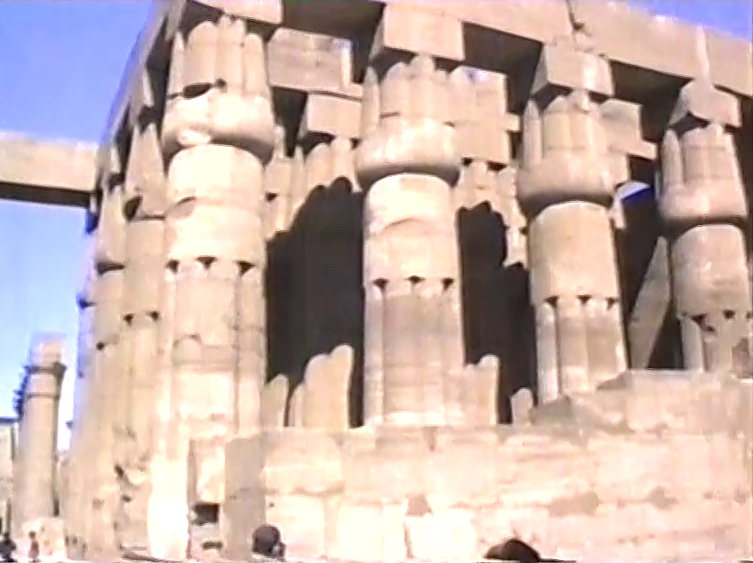 Remains of the Hypostyle Hall
Remains of the Hypostyle Hall
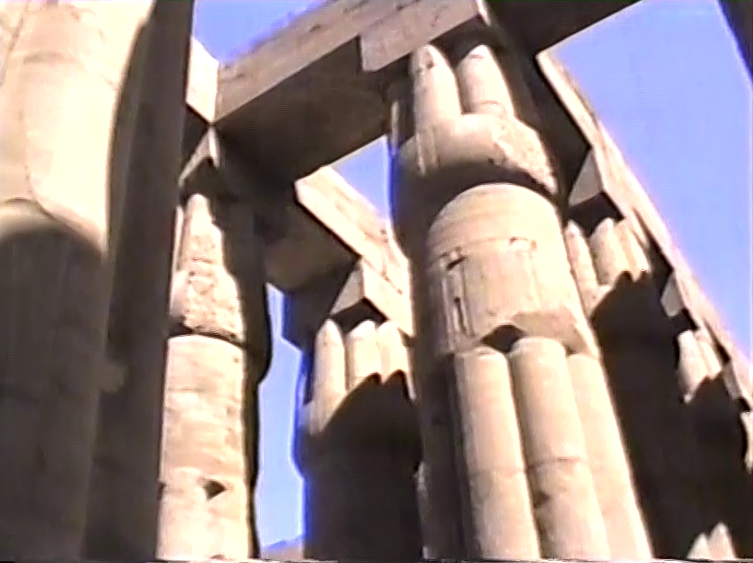 Remains of the Hypostyle Hall, details
Remains of the Hypostyle Hall, details
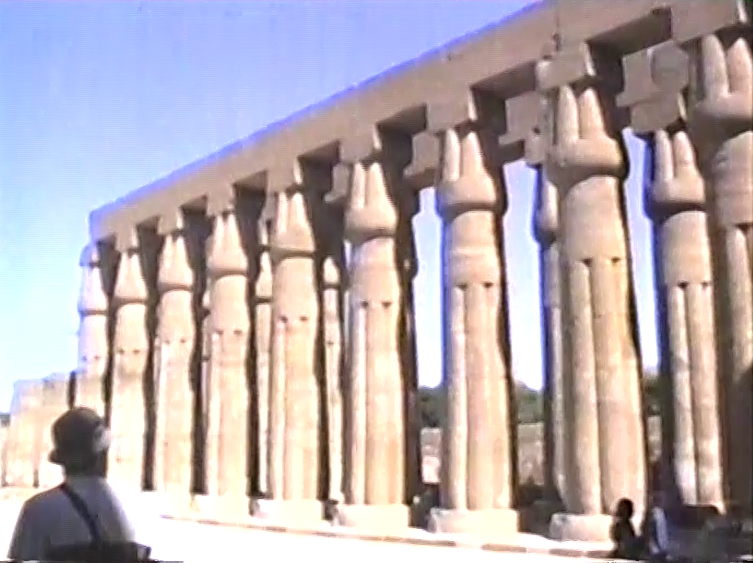 East colonnade within the Court of Amenhotep III
East colonnade within the Court of Amenhotep III
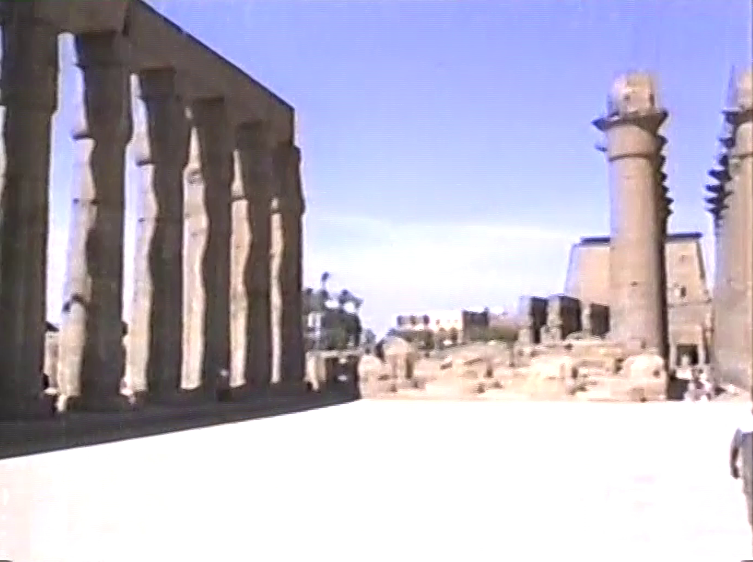 Court of Amenhotep III and the west colonnade (to the left)
Court of Amenhotep III and the west colonnade (to the left)
When we left the temple, there was in front of us the beginning of the Avenue of Sphinxes. This is a paved road along which there are sphinxes on both sides and hence the name. This paved route used to link directly the temples of Karnak and Luxor.
In Ancient Egypt, in Thebes to be more precise, there used to be a major celebration of the Opet Festival once a year. The celebration lasted for 11 days at the time when the Nile flooded and the purpose of the celebration was to promote the fertility of god Amun, as well as the pharaoh himself, who led the celebration. The tradition required that god Amun was brought, symbolically, together with his wife Mut and son Khonsu from the temple of Karnak to the Luxor Temple by a special boat sailing upstream along the Nile. Since the Luxor Temple was, among other things, dedicated to the mystery of life, the regeneration and fertility, god Amun returned to his fertile form here, as Amun-Min (typically depicted as a man with erect penis, emphasising his fertility attribute in this way), thus regenerating his physical strength and good health, and then he was ready for the new life cycle. After all of this was symbolically completed, the gods went back to Karnak, but this time along the Avenue of the Sphinxes.
As I’ve said, these two temples (Karnak and Luxor) are situated at around 2.5 km one from the other. The construction of the Avenue of the Sphinxes along this route started during the period of the New Kingdom (1550-1069 BCE) and was finished in the 4th century BCE. On both sides there are statues of sphinxes and there is a total of over 1000, or 1057 to be more precise, of the original sculptures. Over time, sand started to deposit at the Luxor Temple and it is certain that the Nile also brought a lot of material, so this section of the avenue has been removed from the sight and in the meantime houses were built over most of this wide path. The first traces of the Avenue of the Sphinxes near Luxor were discovered in 1949 and then the excavations slowly started.
The statues are divided into three groups depending on what exactly they depict. The first group, which is near the Temple of Karnak has the shape of rams. Ram was associated with different gods, but in any case it was particularly admired for its virility and its warrior-like attributes.
The second group, with the body of a lion and the head of a ram, lines up the length of around 300 m, between the Karnak Temple Complex (Temple to god Amun-Ra) and the Temple to goddess Mut or Mut Temple.
The third and the biggest group of statues (covering around 2 km of the avenues) shows sphinxes, i.e., the body of a lion and the human head. It was precisely a part of that which we could see in front of the Luxor Temple in 2001.
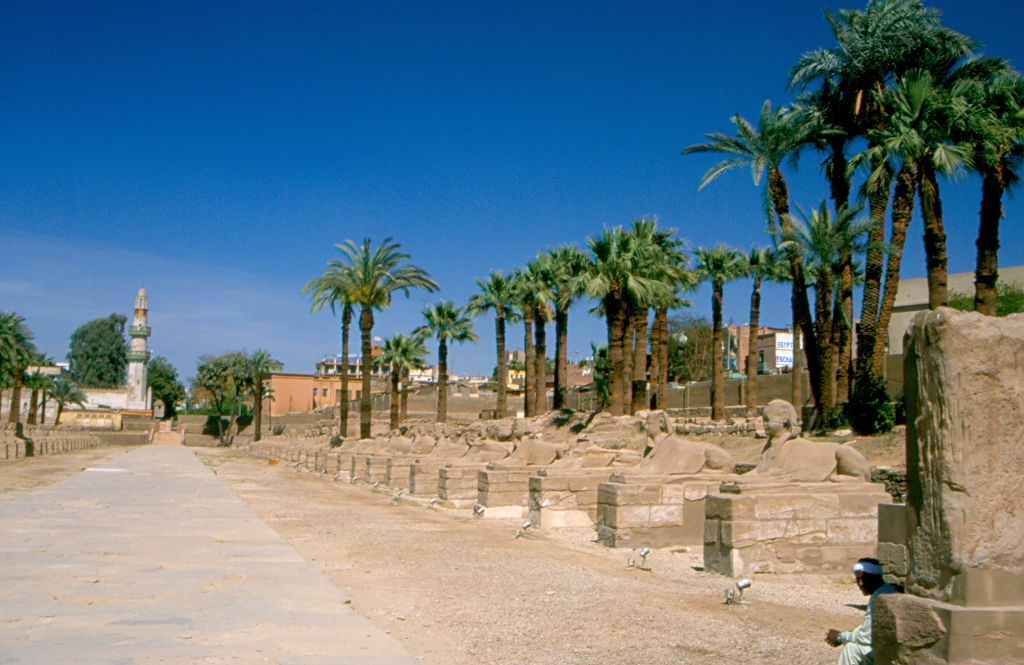 Avenue of Sphinxes near the Luxor Temple in 2001
Avenue of Sphinxes near the Luxor Temple in 2001
When I was here again in 2021, as a part of a daily excursion from Hurghada, the visit to Luxor was not included into the sightseeing programme. On the other hand, as it turned out, I had visited the city just one day before the Avenue of the Sphinxes, restored over its entire length, was opened to the public. This took place on 25 November 2021. On the occasion, a spectacular grand reopening was staged. I think it would be lovely if I were to go to Luxor again, but travelling by myself, with more time, so that I could see it all nicely and without any rush, and to have an opportunity to walk along the Avenue of the Sphinxes. I think would really enjoy that.